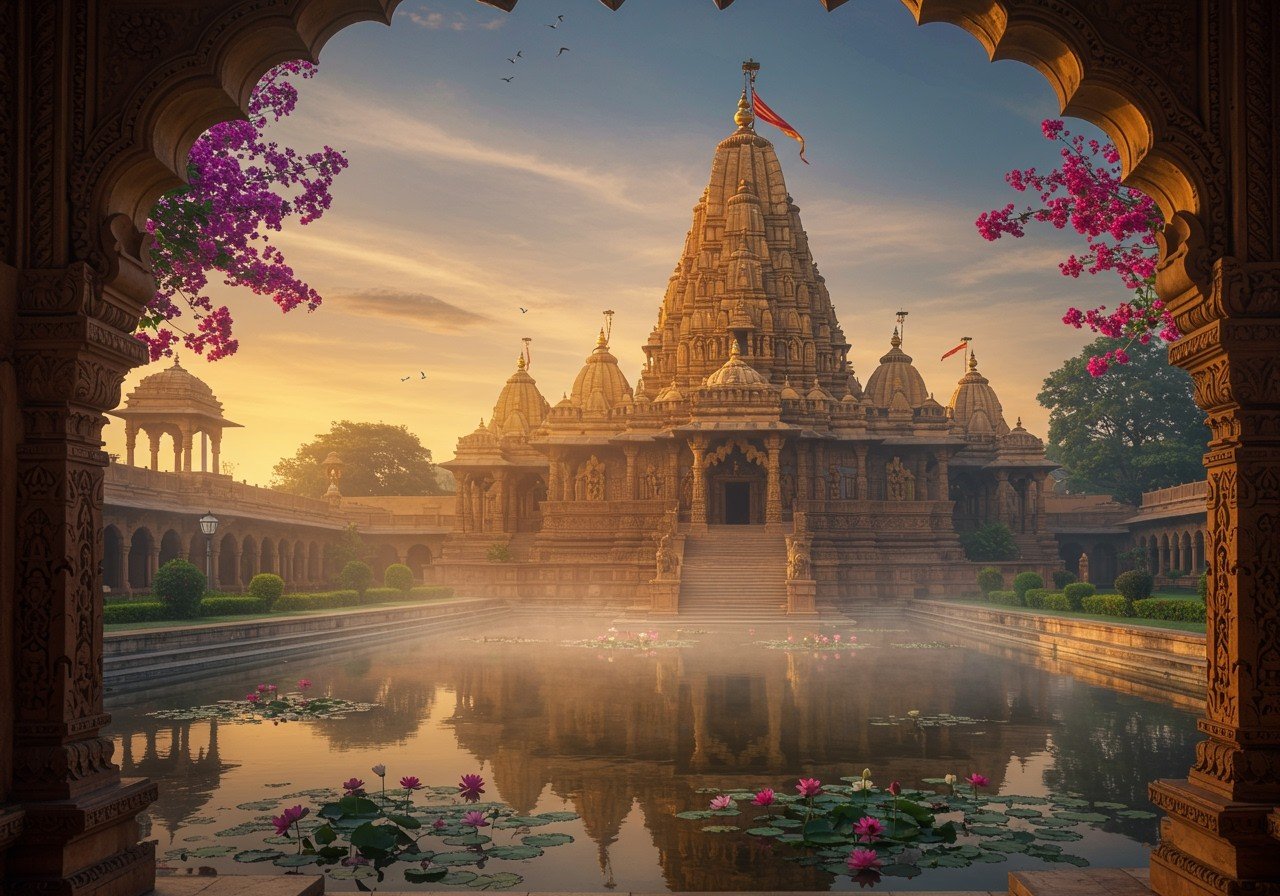
North Indian temple architecture, also known as the Nagara style, stands as a testament to India’s rich cultural heritage. Characterized by its distinctive shikhara, a curvilinear tower rising above the garbhagriha (sanctuary), this style showcases intricate carvings, towering spires, and detailed sculptures, reflecting the region’s deep-rooted spirituality and artistic brilliance.
A Historical Overview
To truly appreciate North Indian temple architecture, it’s essential to understand its historical context. Temple architecture in India evolved over centuries, with the Nagara style crystallizing between 600-750 A.D. Various dynasties, including the Mauryas, Guptas, and Rajputs, have significantly influenced temple construction.
- Mauryas (c. 322-185 BCE): This period witnessed the emergence of early stone temples with simpler designs, laying the foundation for future architectural developments.
- Guptas (c. 320-550 CE): The Gupta era saw the introduction of more complex temple structures and the refinement of architectural elements, marking a significant step in the evolution of temple design.
- Rajputs (c. 647-1200 CE): Rajput rulers patronized the construction of elaborate temples adorned with intricate carvings and opulent details, showcasing their power and devotion.
Historical events, cultural exchanges, and religious beliefs have all played a crucial role in shaping these architectural styles. Later, the Nagara style merged with the Dravida style of South India to create the Vesara style in the Deccan region, further enriching India’s architectural landscape.
Key Architectural Styles and Features
North Indian temples exhibit diverse styles, each with its own unique characteristics:
- Nagara Style: The most prominent style, Nagara is distinguished by its beehive-shaped shikharas and intricate carvings. A prime example is the Kandariya Mahadeva Temple in Khajuraho. Learn more about Hindu Temple Architecture.
- Panchayatana Layout: This layout features five shrines arranged in a specific pattern, with four subsidiary shrines surrounding a central main shrine. The Lakshmana Temple in Khajuraho exemplifies this design. Explore different Hindu Architecture Styles.
- Vesara Style: A harmonious blend of Nagara and Dravidian elements, the Vesara style showcases the architectural confluence of North and South India. This style is prevalent in the Deccan region. Delve into Dravidian Temple Architecture.
Regional variations exist across North India, influencing the design, materials, and ornamentation of temples. Temple iconography and symbolic representations also vary, reflecting local traditions and beliefs.
Regional Variations and Iconic Temples
Different regions in North India showcase unique architectural nuances:
- Rajasthan: Temples in Rajasthan often utilize marble and sandstone, showcasing intricate carvings and opulent details. The Dilwara Temples in Mount Abu are renowned for their exquisite marble work.
- Khajuraho (Madhya Pradesh): The Khajuraho temples are famous for their erotic sculptures and intricate carvings, depicting various aspects of life and spirituality.
- Varanasi (Uttar Pradesh): Varanasi, a city of immense spiritual significance, boasts temples like the Kashi Vishwanath Temple, known for their historical and religious importance.
- Himachal Pradesh: Temples in Himachal Pradesh often blend Hindu and Buddhist architectural styles, reflecting the region’s diverse cultural influences.
Local materials, construction techniques, regional folklore, and traditions all contribute to the distinctive character of these temples.
Architectural Elements and Symbolism
Key architectural elements define North Indian temples:
- Shikhara (Tower): The shikhara, a prominent feature of Nagara architecture, varies in shape and design across different regions and styles. It symbolizes the connection between the earthly and divine realms.
- Mandapa (Pillared Hall): The mandapa serves as a central space for rituals and gatherings within the temple complex. It is often adorned with intricate carvings and pillars.
- Carvings and Sculptures: The elaborate carvings and sculptures adorning North Indian temples depict deities, mythological stories, and scenes from daily life, showcasing the rich artistic traditions of the region.
Common motifs like lotus flowers, elephants, and celestial beings add to the beauty and symbolism of these temples. The layout often includes the garbhagriha (sanctum sanctorum) and pradakshina patha (circumambulatory path). Geometric patterns and symmetry are crucial design elements. Unique elements, such as the stepped tank in the Sun Temple at Modhera, further enhance the architectural richness of these sacred spaces. Discover the Key Elements of Traditional Hindu Architecture.
Contemporary Relevance and Preservation
Temples continue to play a vital role in modern Indian society as centers of cultural and spiritual activity. Preservation efforts, including government initiatives and community involvement, are crucial for safeguarding these architectural treasures. Challenges such as environmental factors and urbanization pose threats to these ancient structures. Tourism, while contributing to local economies, also impacts preservation efforts, necessitating careful management. Successful restoration projects, like the rejuvenation of the Somnath Temple, demonstrate the commitment to preserving India’s architectural heritage. Modern architects often draw inspiration from these traditional designs, ensuring their continued relevance in contemporary architecture. Explore how Hindu Architecture Tradition meets Modern Design.
Poojn.in: Your Source for Sacred Items
Inspired by the beauty of North Indian temples? Bring the sanctity of temple worship home with sacred idols and puja items from Poojn.in. We offer a wide selection of high-quality products to enhance your spiritual practice.
Conclusion
North Indian temple architecture stands as a magnificent testament to India’s rich artistic, cultural, and spiritual heritage. From the towering shikharas to the intricate carvings, each element tells a story of devotion, artistry, and cultural significance. Preserving these architectural marvels is essential for ensuring that future generations can continue to appreciate and learn from the rich legacy of North Indian temple architecture.


